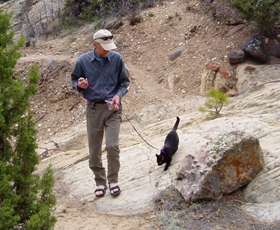Hiking With Cats, April 2009 issue
By
Phyl Newbeck
Posted April 3rd, 2009

Tim Beaman hikes with Cleo on vacation in Bryce National Park, Utah. Photo by Sylvia Lazarnick.
Tim Beaman of Fairfield, VT, admits there aren’t very many things he likes about his cat Cleo. “She’s not friendly. She’s not affectionate. She’s got nothing I normally look for in a cat.” But Cleo does have one thing going for her. She hikes with Beaman and his wife, Sylvia Lazarnick.
When Cleo, now seven, was adopted by the couple, they knew they were going to be doing a lot of traveling. Lazarnick was set to retire from teaching and the duo planned to spend the winter in Utah. Visiting unfamiliar places meant Cleo could no longer wander freely. Initially, she objected to being placed in a harness, but eventually she acquiesced. Five years later, Cleo is a veteran hiker, having joined Beaman and Lazarnick on treks in Utah, Tennessee, and Canada.
James and Darlene Mossman of Northfield, VT, also hike with their cat Toonces. They recall that when Toonces was an indoor/outdoor cat, he refused to accept a leash. After they moved to a home where Toonces must stay indoors, his attitude changed and now he happily submits to a harness. The Mossmans have taken Toonces, now ten, in the woods behind their house and up Northfield’s Mount Paine, which is 1,900 feet in elevation. Toonces generally takes the lead and usually makes the right decisions at trail intersections. The first time the Mossmans took Toonces into the woods, he led them right to the beaver pond, their intended destination. James Mossman suspects this is based on his sense of smell.
That may also explain why Cleo is unwilling to accept any deviation from an out-and-back trail. If her humans try to take a different fork on a return trip, Cleo objects and refuses to follow. Cleo is partial to singletrack trails and does not like wide open areas. She doesn’t mind ridges and stayed happily on leash on a narrow trail with steep drop-offs at Dinosaur National Monument. Her longest hike was five miles roundtrip. Generally, one hour on the trail is enough for her, but she has hiked for close to two. Lazarnick always leads with Beaman following and Cleo in between on her leash. When she gets overheated or tired, Beaman picks her up and carries her in his arms. The couple has learned not to take her out when the ground is too warm, but Cleo is willing to hike on packed snow in the winter. Although uphill can be a problem, Cleo has hiked up to 600 vertical feet on a volcanic cinder cone in southern Utah.
Toonces’ longest hike was also five miles roundtrip, but he has accompanied the Mossmans on excursions of six to eight hours, spending time in a doggie backpack or lounging while the Mossmans eat and admire the view. To prevent heat exhaustion, the couple hikes with Toonces in the early morning or on cool days. Toonces dislikes snow, although he allows Mossman to carry him in the backpack in winter and will sit with him on pine needles in a sunny area.
When Beaman hears a dog coming, he picks Cleo up, and the dogs don’t
seem to notice she is there. Although initially Cleo was bothered by other humans on the trail, she is no longer spooked by footsteps. The Mossmans, however, had to abort an attempt to hike a heavily populated trail with Toonces because of his discomfort. They have not had to deal with dogs, but they noticed that Toonces is aware of canine scent. In the woods, Toonces avoids certain areas where they have later seen evidence of dogs and/or foxes. At home in Vermont, where she is allowed free range, Cleo is a serious hunter, but she does not allow herself to be distracted by chipmunks on the trail. Toonces, however, is easily distracted. The difference is that he has apparently developed a taste for venison and wants to chase deer.
Mossman recommends hiking with feline companions. “It’s a lot of fun,” he said. “People should try it if their cats are willing.” Dr. Stephen Barningham of Mount Mansfield Animal Hospital agrees. He has gone cross-country skiing in the woods with two dogs and one unharnessed cat, but wouldn’t consider taking an unleashed cat to a more populated area. Barningham stressed that cats should be kept on leash on public trails because of the presence of dogs. “There is nothing,” he said, “that suggests that a cat can’t go for a nice long walk if you keep the cat safe from predators or from running away.” Barningham added that a lot depends on the physical condition of the cat, noting that adult cats can probably handle snow and steep terrain better than humans. “It’s a rarity,” he said, “but if you’re willing to get your cat in shape and protect him on the trail, there’s no reason why you can’t do it.”
Phyl Newbeck lives in Jericho with her partner Bryan and two cats, Benji and Elway, who have shown no interest in hiking. When she feels the need to take four-legged friends into the woods, she borrows her neighbors’ canine companions. Phyl is a skier, skater, cyclist, kayaker, and lover of virtually any sport which does not involve motors. She is the author of Virginia Hasn’t Always Been for Lovers: Interracial Marriage Bans and the Case of Richard and Mildred Loving.


